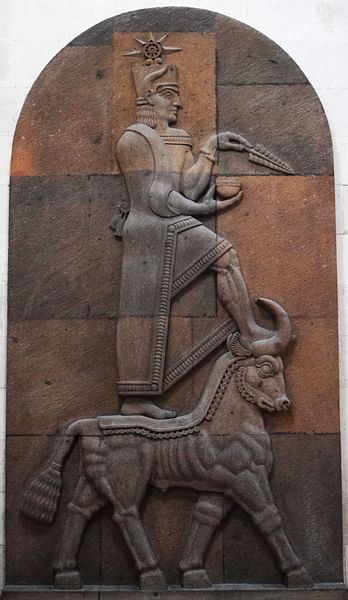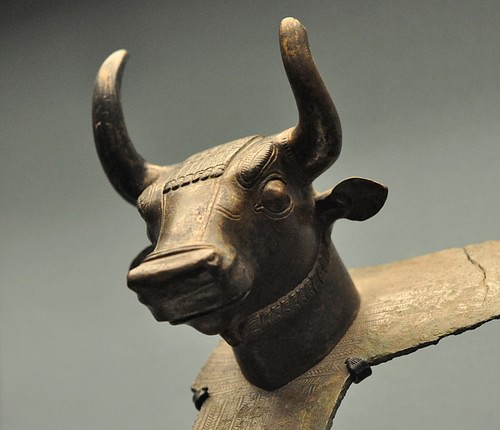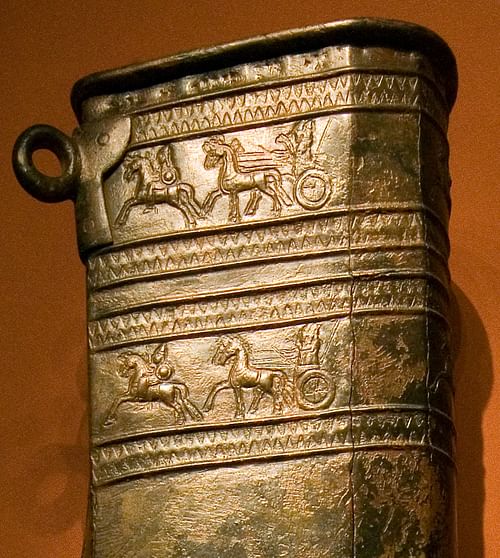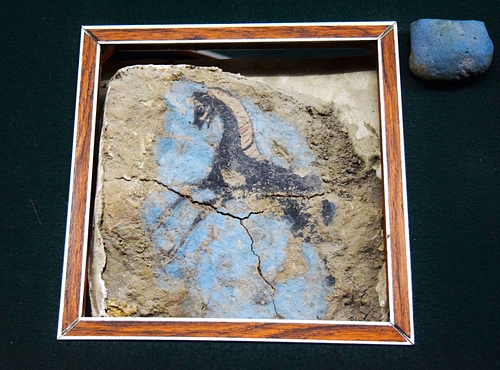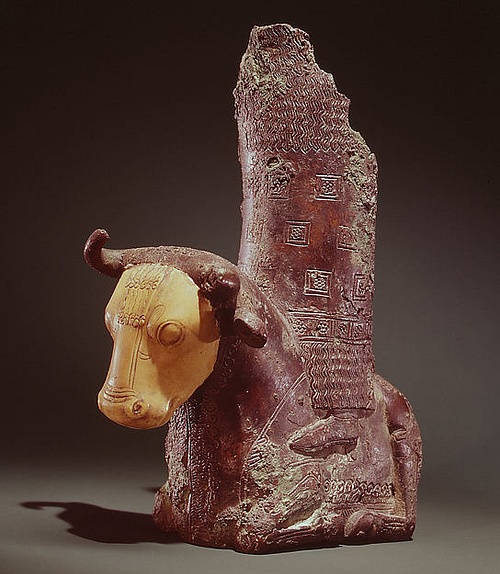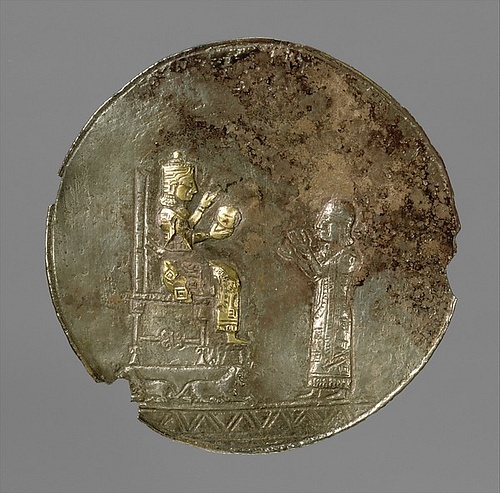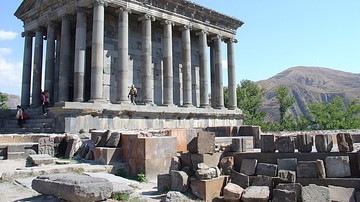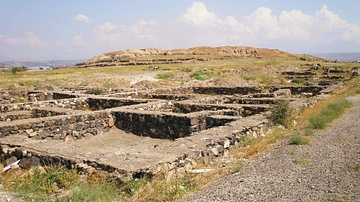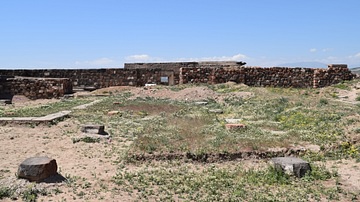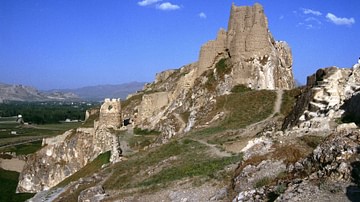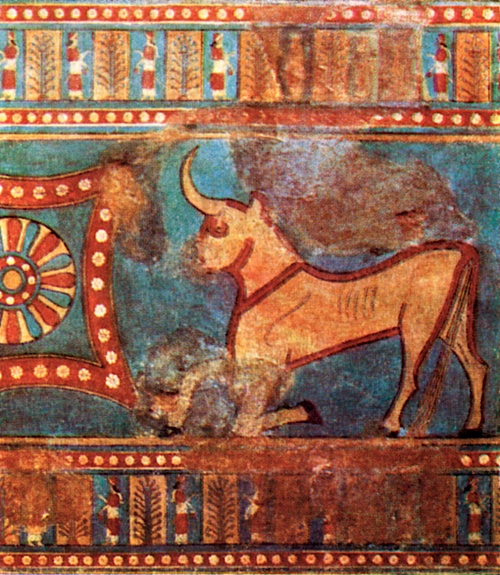
The art produced by the Urartu civilization, which flourished in ancient Armenia, eastern Turkey, and northwestern Iran from the 9th to 6th century BCE, is best seen in bronze figurines of deities, bronze cauldrons with animal and goddess head decorations, and vibrant wall paintings. A mix of Mesopotamian and indigenous subjects coupled with outstanding craft skills make the artworks of Urartu some of the star attractions in the Near Eastern collections of museums worldwide from London to Saint Petersburg.
Ideas & Influences
Overshadowed by its more powerful neighbour Assyria (both in the past and today), without surviving examples of extended text of its own, and having had much of its precious material culture destroyed or looted, it can be difficult to disentangle the art of Urartu from that of the civilizations who were its predecessors, contemporaries, and even successors. One is on safer ground when examining the artefacts themselves in isolation rather than searching for their connection to each other and the art of other cultures. Certain points then become clear - the Urartians were master metalworkers, cauldrons especially being a forte. Wall painters were as accomplished as in any other culture, too. Such skills were acquired and developed over many decades, even centuries, and with such skills, one can presume there was also innovation both in technique and ideas. History shows that expert artists do not copy for very long before they begin to experiment.
The Urartu civilization was only rediscovered in the 19th century CE, and it has a lot of catching up to do with its more famous contemporary cultures, but ongoing excavations are steadily building up a clearer picture of the capabilities, inspirations, and legacy of one of the region's most important Bronze and Iron Age cultures. It is clear that Urartian art was particularly influenced by contemporary Assyrian and Near Eastern art and that produced by the earlier cultures of the Hittites and Hurrians. Such subjects as lions, bulls, mythological creatures (e.g. griffins and centaurs), horse riders, and military themes provide a strong link between all of these cultures. Finally, Egyptian art was not unknown either, and artefacts with hieroglyphs, notably faience bowls and statuettes, have been found at Urartian sites.
A consequence of these cultural connections, coupled with the lack of identifying inscriptions in many cases, is that some artworks can be difficult to positively identify as made by artists from Urartu, Assyria or the Achaemenid Empire. An added difficulty is that many surviving Urartian artworks come from Assyrian sites where they were either taken as loot or which were produced specifically for that market by Urartian craftsmen. These works, though, may well have been produced during a period of political and artistic decline when Urartian art had lost some of its uniqueness. Thankfully, extensive excavations, such as those at Teishebaini (Karmir-Blur), have revealed the wide range of materials, media and subjects typical of Urartian art.
Materials & Media
Metalworking has a long history in the region, dating back to the 10th millennium BCE. Artisans in the Urartu kingdom had access to local mineral deposits which included gold, silver, copper, lead, iron, and tin. Other metals which the artisans and artists of Urartu could use included alloys such as bronze (copper and tin), brass (copper and zinc), and electrum (gold and silver). Artists also used wood, hardwood, stone, bone, stag horns, semi-precious stones (e.g. sardonyx, agate, and cornelian), enamel, faience, and ivory for their work. Common media for Urartian art includes figurines, engraved and inlaid weapons and armour, pottery, wall paintings, and highly decorative furniture.
Large-scale Sculpture
Unfortunately, no large-scale sculpture survives except in fragments. The most important example is the six surviving pieces of a basalt relief statue of the storm god Teisheba. Dating to the 7th century BCE, the original figure stood on a bull facing a second figure with a triple spearhead between the two. It was excavated at Adilcevaz, north of Lake Van, and a full reconstruction has been made which can be seen in the Erebuni Historical and Archaeological Culture Preserve in Yerevan, Armenia.
The largest sculpture suggested by a surviving fragment is a life-size figure of a ruler. Only the torso of the figure has survived but the narrow beard and ends of long hair suggest a royal person. The left hand holds a bow and some arrows while the right hand holds either a club or whip. That such large figure statues were erected at Urartian temples is known through Assyrian inscriptions and artwork which describe and depict attacks on Urartu during the mid- to late-8th century BCE.
Metalwork
Metalworkers cut, cast, embossed, engraved, and inlaid metal to produce such ornate goods as jewellery of all kinds, helmets, shields, quivers, pectorals, small seals and amulets in the shape of bells, horse harness pieces, horse bits, belts, buckles, figurines, and candelabra. Bronze and copper seem to have been the materials of choice. Large bronze cauldrons were a speciality, often with three-dimensional animal or human heads around the rim and as handles. A magnificent bronze bull's head handle ornamentation can today be seen in the British Museum in London.
Winged female goddesses are another common choice for cauldron decorations, and they perhaps represent the goddess Tushpuea, the consort of Shivini, the sun god. A splendid example is today in the Hermitage Museum in Saint Petersburg. The cauldrons, having rounded bottoms, were set on embossed bases or tripods. The type, in general, is very similar to Etruscan cauldrons, which were likely inspired by the Urartu model, indeed, some examples may well be of Urartian manufacture.
Bronze plaques, placed in niches in interior walls, were etched with geometrical designs and scenes of horsemen and chariots, sometimes even buildings, too. Some plaques have gold and silver leaf decoration. Bronze belts were engraved with hunting scenes, for example, lion-hunts. Shields had large central bosses made in the form of mythical creatures, lions, and bulls. Shields may also show concentric bands of embossed lions and bulls as in the two examples now in the British Museum in London. Those bronze items such as the more ornate shields and weapons belonging to the royal household are so identified by inscriptions which have also helped to identify Urartian works found outside Asia.
Wall Painting & Flooring
Excavations have revealed both public and private buildings in Urartian cities had interior wall paintings. The palace complex at the fortress site of Erebuni alone had over 2,000 square metres of wall paintings. Painted on plaster, surviving sections and fragments show scenes with animals, mythical creatures, processions of gods, and scenes from everyday life such as agriculture, cattle breeding, and hunting. The scenes are usually set within broad decorative borders made up of palmettes, geometric shapes or small repeated human figures. Backgrounds are usually white, outlines are drawn in black, and blue and red are the most commonly used colours.
Flooring was of stone in the more prestigious buildings with surviving examples having either large basalt slabs or even large-stone polychrome mosaics with geometric designs. Interior walls could have cavities cut into them into which were placed not only the decorative bronze plaques described above but also decorative cut stone slabs in red, white, or black.
Furniture
Furniture was placed in elite tombs, especially thrones and matching stools. Perhaps largely made of wood, they have not survived complete but fragments made from cast or solid metal, usually bronze or copper, do survive. These remnants are highly decorative and take the form of finely sculpted standing human figures or mythical creatures such as winged bulls with human heads or winged bird-lion hybrids which were intended to protect the person who sat on the throne. In some examples of these figures the face may have been rendered in gold or semi-precious stone and, consequently, this part has long-since been removed by looters. The recesses of many of these miniature sculptures contain traces of gold leaf suggesting that the whole was once covered in shining gold.
Pottery
A wide range of vessels was made both for everyday and ceremonial use. The most common type has a polished red surface while a typical form is the one-handled jug. Large jars were made and then sunk into the floors of storage buildings in which were kept foodstuffs, especially grain, oil, and wine. The largest examples of these had a capacity to hold 750 litres (200 gallons). A label etched in cuneiform very often indicates the contents of storage vessels. One unusual form is the vessel made in the shape of a boot, complete with painted stitching and laces. Several examples have been excavated from the fortress city of Teishebaini and date to the 8th century BCE. Finally, pyxides (small lidded boxes) were produced and decorated with relief or painted scenes of religious and everyday life. There are several surviving examples of these in stone, too.
Religious Art
Religious art includes bronze figurines of prominent gods such as Haldi, Teisheba, and Shivini. Haldi, the head deity and god of war, is often portrayed as a man with or without a beard standing on a lion, symbolic of his power, courage, and virility. In contrast, Teisheba, the storm god, is shown standing on a bull and holding thunderbolts in his hands. Shivini, the sun god, was often represented as a kneeling man holding a winged solar disk, and was, therefore, likely inspired by the Egyptian god of the same association, Ra.
Some figurines of deities are unidentified, such as a female goddess rendered in bone, and there are, too, strange hybrid figurines of a fish-man, bird-man, and scorpion-man. These latter creatures, frequently painted on storeroom interior walls, were likely regarded as protective spirits. The Tree of Life, another motif from Mesopotamian art, appears in various media, typically with a figure standing either side of it and making offerings.
Weapons were made using precious materials which were not for military use but destined as offerings at temples to the gods. Assyrian inscriptions describe temples in Urartu containing silver bows and arrows, gold swords, silver javelins and spears, and even silver chariots. Finally, as perhaps is to be expected for a war god, Haldi is frequently represented on engraved weapons, belts, shields, and medallions.
Legacy
As already mentioned, there is a striking resemblance in many features of the art and objects produced in Urartu and other cultures in the Near East but also further afield in Archaic Greece, especially on Crete, Rhodes, Samos, Delphi, Corinth, and elsewhere. Etruscan art shows similarities too. Whether these ideas arose independently or were transferred via traders, the exchange of objects or by the movement of artists themselves is a moot question. The point of contact between these various Mediterranean cultures would most likely have been the thriving port of Poseidon (Al Mina) at the mouth of the Orontes River in southeast Turkey, which was controlled by Urartu in the first half of the 8th century BCE.
Some motifs seen in the art of Urartu continued to appear in the art of the region into much later times, just as the Urartian language continued long after the cities had been taken over by the Medes and successive powers. The Tree of Life motif, for example, was still being used in the folk songs and illustrated manuscripts produced in Armenia during the medieval period.
This article was made possible with generous support from the National Association for Armenian Studies and Research and the Knights of Vartan Fund for Armenian Studies.
